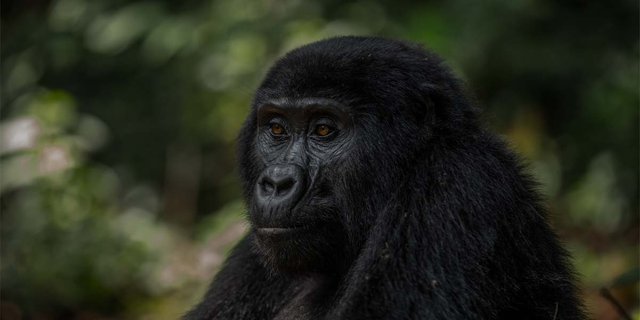A mountain Gorilla Census In Uganda: Tracking The Future
Mountain Gorilla in Bwindi Impenetrable Forest. Photo by Eric Manzi
Uganda is currently holding a mountain gorilla census in the Bwindi Impenetrable Forest. This is aimed at providing updated data on the remaining mountain gorilla population.
Mountain gorillas are an endangered primate species living in the forested mountains of Bwindi Impenetrable Forest, the adjacent Sarambwe Reserve, and the Virunga Mountains along the Uganda, Rwanda, and DRC borders. Mountain gorilla survival is tied to the protection and conservation of their unique ecosystems.
Understanding the Mountain Gorilla Census
A mountain gorilla census is a systematic count of the giant apes conducted periodically, focusing on data collection that features family sizes, health status, births, and habitats.
It is done by researchers, rangers, and conservationists who traverse the forested mountains to locate and record the gorilla families they encounter. Collected data is used to monitor the trends and implement the much-desired conservation strategies.
The last mountain gorilla census, completed in 2019, established 459 individual mountain gorillas in the Bwindi Impenetrable Forest. This accounts for nearly half of the total remaining gorilla population on the planet. The ongoing census seeks to update these figures, identify emerging threats, and assess the impact of past sustainability and conservation efforts.
Significance of the Census
The census enables the collection of accurate data that informs better conservation policies. These focus on ecosystem conservation and best sustainability practices. It also guides on the best measures to follow when involving the community in habitat protection and reducing poaching.
The collected census data supports local and international collaborations aimed at preserving mountain gorillas in their last remaining ecosystems.
About Bwindi Impenetrable Forest
Bwindi Impenetrable Forest is Uganda's top gorilla trekking destination. It is forested, covering a land area of 321 square kilometers of both lowland and montane forests.
Bwindi is home to over 120 mammal species, including mountain gorillas and chimpanzees. It is also home to over 400 plant species, 350 bird species, and 200 butterfly species, including Albertine endemics. It is based on this diversity and outstanding natural significance that the park was listed as a UNESCO World Heritage Site.
Bwindi Gorilla Trekking Safaris
Bwindi currently has 22 habituated gorilla families that are open to tourism. This offers one a unique opportunity to observe mountain gorillas in their natural habitats. Bwindi gorilla trekking safaris offer the ultimate primate trekking adventures and help to generate revenue to support community and wildlife conservation initiatives.
The experiences are limited and closely monitored to minimize human impact on the mountain gorillas and their ecosystem. You can opt for a normal gorilla trekking tour that allows you up to an hour in the presence of the mountain gorillas.
The mountain gorilla habituation experience is more extensive and experiential, allowing you up to 4 hours with the gorillas. This is, however, restricted to the southern sector of Bwindi called Rushaga.
Uganda Gorilla Conservation Journey
The Uganda gorilla conservation journey has, over the years, been compromised by the surrounding communities. Before the gorilla parks were gazetted, the community entirely depended on the forest ecosystem for food and survival. This, however, exposed the wildlife to poaching and other human activities like farming that encroach on their habitats.
Directly involving the community in tourism activities, conservation, and sustainability has helped to minimize impact. This is because of the creation of revenue-sharing programs and direct employment opportunities that enable the local people to directly earn from gorilla tourism. It creates a sense of ownership and responsibility that makes the people more vigilant about gorilla conservation programs. This has, in turn, contributed a great deal to mountain gorilla protection.
The Future of Gorilla Conservation
The ongoing census is a step into the future of gorilla conservation. Census results will be used as a tool to adapt conservation policies. It is vital to continuously involve the local communities, governments, and international partners for a holistic gorilla conservation program.
Such collaborative research and tourism efforts will make Uganda a leader in mountain gorilla conservation. Let us therefore commit to responsible and sustainable travel that focuses on minimal impacts on the community and wildlife ecosystem.
Visit Uganda for gorilla trekking and habituation experiences for more information.
